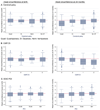Developmental correlates of head circumference at birth and two years in a cohort of extremely low gestational age newborns
- PMID: 19555967
- PMCID: PMC2803763
- DOI: 10.1016/j.jpeds.2009.04.002
Developmental correlates of head circumference at birth and two years in a cohort of extremely low gestational age newborns
Abstract
Objectives: To evaluate the developmental correlates of microcephaly evident at birth and at 2 years in a cohort born at extremely low gestational age.
Methods: We assessed development and motor function at 2 years of 958 children born before the 28th week of gestation, comparing those who had microcephaly at birth or 2 years with children with normal head circumference while considering the contribution of neonatal cranial ultrasound lesions.
Results: A total of 11% of infants in our sample had microcephaly at 2 years. Microcephaly at 2 years, but not at birth, predicts severe motor and cognitive impairments at 2 years. A total of 71% of children with congenital microcephaly had a normal head circumference at 2 years and had neurodevelopmental outcomes comparable with those with normal head circumference at birth and 2 years. Among children with microcephaly at 2 years, more than half had a Mental Developmental Index <70, and nearly a third had cerebral palsy. The risks were increased if the child also had cerebral white matter damage on a cranial ultrasound scan obtained 2 years previously.
Conclusion: Among extremely low gestational age newborns, microcephaly at 2 years, but not at birth, is associated with motor and cognitive impairment at age 2.
Conflict of interest statement
The authors declare no conflicts of interest.
Figures


References
-
- Cooke RW, Lucas A, Yudkin PL, Pryse-Davies J. Head circumference as an index of brain weight in the fetus and newborn. Early Hum Dev. 1977;1:145–149. - PubMed
-
- Hack M, Breslau N, Fanaroff AA. Differential effects of intrauterine and postnatal brain growth failure in infants of very low birth weight. Am J Dis Child. 1989;143:63–68. - PubMed
-
- Gale CR, O’Callaghan FJ, Godfrey KM, Law CM, Martyn CN. Critical periods of brain growth and cognitive function in children. Brain. 2004;127:321–329. - PubMed
-
- Gale CR, O’Callaghan FJ, Bredow M, Martyn CN. The influence of head growth in fetal life, infancy, and childhood on intelligence at the ages of 4 and 8 years. Pediatrics. 2006;118:1486–1492. - PubMed
-
- Cheong JL, Hunt RW, Anderson PJ, Howard K, Thompson DK, Wang HX, et al. Head growth in preterm infants: correlation with magnetic resonance imaging and neurodevelopmental outcome. Pediatrics. 2008;121:e1534–e1540. - PubMed
Publication types
MeSH terms
Grants and funding
LinkOut - more resources
Full Text Sources
Medical

